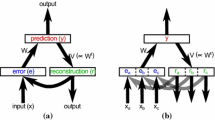Abstract
Predictive coding has been argued as a mechanism underlying sensory processing in the brain. In computational models of predictive coding, the brain is described as a machine that constructs and continuously adapts a generative model based on the stimuli received from external environment. It uses this model to infer causes that generated the received stimuli. However, it is not clear how predictive coding can be used to construct deep neural network models of the brain while complying with the architectural constraints imposed by the brain. Here, we describe an algorithm to construct a deep generative model that can be used to infer causes behind the stimuli received from external environment. Specifically, we train a deep neural network on real-world images in an unsupervised learning paradigm. To understand the capacity of the network with regards to modeling the external environment, we studied the causes inferred using the trained model on images of objects that are not used in training. Despite the novel features of these objects the model is able to infer the causes for them. Furthermore, the reconstructions of the original images obtained from the generative model using these inferred causes preserve important details of these objects.
Access this chapter
Tax calculation will be finalised at checkout
Purchases are for personal use only
Similar content being viewed by others
References
Mumford, D.: On the computational architecture of the neocortex - II the role of cortico-cortical loops. Biol. Cybern. 66(3), 241–251 (1992)
Pennartz, C.M.A.: The Brain’s Representational Power: On Consciousness and the Integration of Modalities. MIT Press, Cambridge (2015)
Rao, R.P.N., Ballard, D.H.: Predictive coding in the visual cortex: a functional interpretation of some extra-classical receptive-field effects. Nat. Neurosci. 2(1), 79–87 (1999)
Spratling, M.W.: Reconciling predictive coding and biased competition models of cortical function. Front. Comput. Neurosci. 2, 4 (2008)
Desimone, R., Duncan, J.: Neural mechanisms of selective visual attention. Annu. Rev. Neurosci. 18(1), 193–222 (1995)
Spratling, M.W.: Unsupervised learning of generative and discriminative weights encoding elementary image components in a predictive coding model of cortical function. Neural Comput. 24(1), 60–103 (2012)
Whittington, J.C.R., Bogacz, R.: An approximation of the error backpropagation algorithm in a predictive coding network with local hebbian synaptic plasticity. Neural Comput. 29(5), 1229–1262 (2017)
Jehee, J.F.M., Ballard, D.H.: Predictive feedback can account for biphasic responses in the lateral geniculate nucleus. PLoS Comput. Biol. 5(5), e1000373 (2009)
Ledig, C., et al.: Photo-Realistic Single Image Super-Resolution Using a Generative Adversarial Network, pp. 1–14. arXiv (2016)
Michael Mathieu, Y.L., Couprie, C.: Deep multi-scale video prediction beyond mean square error. arXiv (2015)
Kauderer-Abrams, E.: Quantifying Translation-Invariance in Convolutional Neural Networks. arXiv (2017)
Zeiler, M.D., Krishnan, D., Taylor, G.W., Fergus, R.: Deconvolutional networks. In: Proceedings of the IEEE Computer Society Conference on Computer Vision and Pattern Recognition, pp. 2528–2535 (2010)
Acknowledgement
The research work reported in this paper is carried out under European Union Horizon 2020 Program under Grant Agreement 720270-Human Brain Project SGA1 to C.M.A. Pennartz.
Author information
Authors and Affiliations
Corresponding author
Editor information
Editors and Affiliations
Rights and permissions
Copyright information
© 2018 Springer Nature Switzerland AG
About this paper
Cite this paper
Dora, S., Pennartz, C., Bohte, S. (2018). A Deep Predictive Coding Network for Inferring Hierarchical Causes Underlying Sensory Inputs. In: Kůrková, V., Manolopoulos, Y., Hammer, B., Iliadis, L., Maglogiannis, I. (eds) Artificial Neural Networks and Machine Learning – ICANN 2018. ICANN 2018. Lecture Notes in Computer Science(), vol 11141. Springer, Cham. https://doi.org/10.1007/978-3-030-01424-7_45
Download citation
DOI: https://doi.org/10.1007/978-3-030-01424-7_45
Published:
Publisher Name: Springer, Cham
Print ISBN: 978-3-030-01423-0
Online ISBN: 978-3-030-01424-7
eBook Packages: Computer ScienceComputer Science (R0)


